Gooseberries Nutrition facts
Gooseberries are small, round to oval berries of European origin. They grow in the wild all over the temperate climates of Europe, North America, and Siberia. Botanically, they related very closely to currants, and belong to the same family of Grossulariaceae, in the genus, Ribes. These berries are packed with pigment antioxidant polyphenolics and vitamins.
Scientific name: Ribes uva-crispa L.
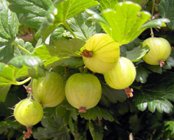
|
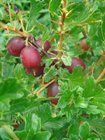
|
| Gooseberries (Ribes uva-crispa L.) Photo courtesy:John Haslam. |
Purple-red gooseberry shrub. Photo courtesy: Rhian. |
Gooseberries (R. uva-crispa L.) are one of the four wild Ribes species (R. alpinum L., R. rubrum L. and R. petraeum Wulf.) growing in the Northern Hemisphere. As in currants, gooseberry also grows best in regions where summers are humid, but winter is severe and chilling.
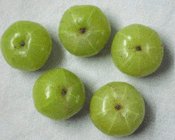
|
| Amla-Indian gooseberries (Phyllanthus emblica). |
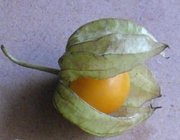 |
| Cape gooseberry (Physalis peruviana). |
Gooseberry plant is a fast-growing, small deciduous shrub growing about 4-6 ft in height, featuring sharp thorns all along its woody branches. The plant begins fruiting 2-3 years after plantation. Berries come in many shapes, colors, and tastes. They can be round, oval, pear-shaped or elongated, green, white, yellow, purple, red-brown or black color, sweet and tart. Their outer surface can be smooth or fuzzy (hairy) with conspicuous veins. Inside, a berry may hold 15-30 tiny edible seeds. In general, the berries measure 1-2 cm in width and weigh about 4 g to 10 g.
Indian gooseberries, also known as amla in the subcontinent, belong to a different family of Euphorbiaceae. Their scientific name is Phyllanthus emblica. Indian gooseberry features a transversely spherical shape with a light green color. Amla berries are exceptionally high in antioxidants and vitamin C. For the same reason; they are excessively acidic and bitter (astringent) in taste.
Cape gooseberry (Physalis peruviana), also known as Peruvian cherry in the US, is native to the South American Andes region. The berries are small, round, orange-yellow in color, encased inside a Chinese lantern-like papery thin husk.
Health benefits of Gooseberries
Gooseberries are low in calories; 100 g of fresh berries hold just 44 calories. As in blackcurrants, they too have significantly high amounts of phenolic phytochemicals, especially flavones and anthocyanins. Both of these compounds have been found to have numerous health-benefiting effects against cancer, aging, inflammation, and neurological diseases.
They are moderately good in anti-oxidant values. At 3277 μ mol TE/100g, gooseberries have an oxygen radical absorbance capacity (ORAC) value, which can be comparable to that of red currants (3387umol TE/100g).
The berries are an excellent source of vitamin-C. 100 g of fresh berries provide 27.7 μg or 46% of daily-recommended intake values of vitamin C. Research studies have shown that consumption of fruits rich in vitamin C helps the human body develop immunity against infectious agents, and helps scavenge harmful oxygen-free radicals from the human body.
They carry a small amount of vitamin A. 100 g berries have 290 IU or 10% of the RDA of this vitamin. Vitamin A is required for maintaining the integrity of mucosa and skin and essential component of the visual cycle. Also, the consumption of natural fruits rich in vitamins and flavonoid antioxidants has been found to protect from lung and oral cavity cancers.
Fresh berries contain small amounts of essential vitamins such as pyridoxine (vitamin B-6), pantothenic acid (vitamin B-5), folates, and thiamin (vitamin B-1). Some of these vitamins are essential in the sense that the body requires them for metabolism from external sources to replenish.
Furthermore, gooseberries contain moderate levels of minerals such as copper, calcium, phosphorus, manganese, magnesium, and potassium.
Indian gooseberries (amla) are exceptionally rich in vitamin C. 100 g of amla carry astoundingly 445 mg of vitamin C. However, these anti-oxidant properties come from other anti-oxidant compounds in them like tannins (emblicanin, punigluconin, pedunculagin, etc.)
| Principle | Nutrient Value | Percent of RDA |
|---|---|---|
| Energy | 44 Kcal | 2% |
| Carbohydrates | 10.18 g | 8% |
| Protein | 0.88 g | 1.5% |
| Total Fat | 0.58 g | 3% |
| Cholesterol | 0 mg | 0% |
| Dietary Fiber | 4.3 g | 11% |
| Vitamins | ||
| Folates | 6 mcg | 1.5% |
| Niacin | 0.300 mg | 2% |
| Pantothenic acid | 0.286 mg | 6% |
| Pyridoxine | 0.080 mg | 6% |
| Riboflavin | 0.030 mg | 2% |
| Thiamin | 0.040 mg | 3% |
| Vitamin A | 290 IU | 10% |
| Vitamin C | 27.7 mg | 46% |
| Electrolytes | ||
| Sodium | 1 mg | 0% |
| Potassium | 198 mg | 4% |
| Minerals | ||
| Calcium | 25 mg | 2.5% |
| Copper | 0.070 mg | 8% |
| Iron | 0.31 mg | 4% |
| Magnesium | 10 mg | 2.5% |
| Manganese | 0.144 mg | 6% |
| Phosphorus | 27 mg | 4% |
| Zinc | 0.12 mg | 1% |
Selection and storage
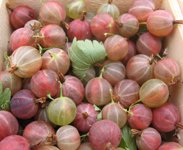
|
| Fresh gooseberries in a market. Photo courtesy: janeyhenning. |
In the USA markets, fresh gooseberries and currants begin to appear by July. Buy fresh harvest, ripe, firm, bright-colored berries to eat as table fruits or to use in desserts. Choose mature but unripe berries to make a tart and to employ in cooking. Avoid berries that are excessively soft, shriveled, and with bruises with leaking juice.
If not used immediately, store them in the refrigerator where they keep fresh for a few days.
Preparation and serving methods
Gooseberries are one of the popular fruits all over Great Britain. Berries handpicked from the wild can be consumed on their own.
At home, wash them in cold water. Trim off stems. Fresh berries can be eaten on their own without much preparation as they are just like currants, grapes, etc.
Here are some serving tips:
Fresh, delicious, sweet gooseberries can be eaten all alone as table fruits/salads, especially some varieties like red-London, purple, early sulfur, etc.
Tart, astringent quality berries are favored in fish, poultry, and meat dishes.
They are used in the agro-food industry to prepare jam, jellies, juice, sauce, chutney, etc.
The berries are also employed in muffins, pie fillings, and ice creams.
Safety profile
Allergy and intolerance to gooseberries are rare. They can be consumed safely in pregnancy. (Medical disclaimer).
≻≻-Back to Fruits from Gooseberries. Visit here for an impressive list of all varieties of fruits with complete illustrations of their nutrition facts and health benefits.
≻≻-Back to Home page.
Further reading and Resources:
Stanford School of Medicine Cancer information Page- Nutrition to Reduce Cancer Risk.
Aamla - Antioxidant and micronutrient potential of common fruits available in the Indian subcontinent..